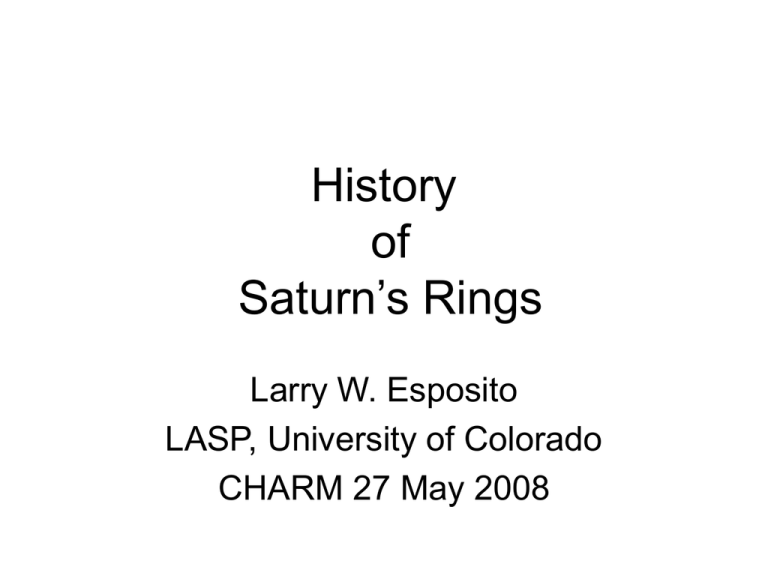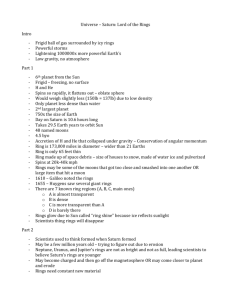History of Saturn’s Rings Larry W. Esposito
advertisement

History of Saturn’s Rings Larry W. Esposito LASP, University of Colorado CHARM 27 May 2008 Launched on October 15, 1997 from KSC 7 Year cruise on VenusVenus-Earth-Jupiter Gravity Assist trajectory 30 June / 1 July 2004 Saturn’s “Northern Lights” GEYSER COMPOSITION (Waite et al. 2006; Hansen et al., 2006) H2O 91 3 %mol CO2 3.2 0.6 %mol N2 4 1 %mol CH4 1.6 0.4 %mol CO < 0.9 %mol NH3, HCN, C2H2, C3H8 < 0.5 % mol (i.e., detected) *Inferred from a combination of INMS and UVIS data Cassini observations show Saturn’s rings may be ancient • Saturn’s rings are made of billions of small pieces of ice orbiting Saturn, they resemble the planet-forming disks surrounding stars • Cassini’s Ultraviolet Imaging Spectrograph (UVIS) observes light reflected from Saturn’s rings and watches stars pass behind the rings • Voyager observations indicated the rings are youthful, but Cassini shows even younger ages: the range of ages is not consistent with a single event creating Saturn’s rings Saturn’s rings were a 17-th century puzzle … The moons ‘shepherd’ the ring particles COLLISIONAL CASCADE USES UP THE RING MATERIAL TOO FAST! Collisional evolution shows original material lost UVIS finds clumps and moonlets in Saturn’s F ring • Cassini detects 13 events: temporary aggregations and one possible moonlet • These indicate clumping of ring particles that recycles the fragments of shattered moons Search Method • Search tuned for 1 VIMSconfirmed event – Optimal data-bin size – min VIMS UVIS Pywacket -15 km 0 15 km Butterball Fluffy Broad and narrow features in gamma Arae 7 Feature 9 8 Ring occultations show self-gravity wakes • Multiple occultations provide a tomographic view of ring structures too small to be seen by the cameras • Autocovariance indicates elongated transient clumps, as predicted in simulations • We may have greatly underestimated ring heterogeneity, mass and age Numerical simulations show collisions and self-gravity effects will create transient elongated trailing structures. UVIS HSP 2D autocorrelation UVIS occs inverted 2D autocorrelation => FFT => image Numerical simulations show a spider-web structure. The ring opacity underestimates mass of the B ring! Ring history • We believe Saturn’s rings were created when a moon was shattered by a meteorite impact • The pieces formed a ring around the planet • But, the pieces can recollect to form new moons • Which are shattered later, to form new rings, and so on… Conclusion: Age of Saturn’s rings • Recycling allows the rings to be as old as the solar system, although continually changing • Because the rings have more mass than previously thought, their surfaces can still be bright and icy after 4 billion years Backup Slides Are ancient rings possible? Regolith model for pollution: Consider an infinite slab of depth, D The regolith depth at time t: h(t) For a moonlet or ring particle, D corresponds to the diameter. Markov chain simulation matches analytic test case For an impactor size distribution that is a power law of index 3, we can solve the differential equation for h(t), assuming all material is excavated: h(t) = Hmax[1 - exp(-t/T0)] Hmax = H1 amax T0 = H max Ý/ FGYm Realistic case for Saturn • Use Cuzzi and Estrada (1998) impactor size distribution • Compare to Quaide and Oberbeck (1975) lunar regolith model • Our Markov chain model result gives depth within a factor of 2 of their values for 105 < t < 109 years This implies young rings? The fractional pollution of the regolith, fp, is given by fp = FG mÝt / h(t) For meter -sized particles, fp is 0.01 in 108 years, a rough upper limit from ring observations at microwave Estimating ring age from the volume pollution rate For a ring system with surface mass density, , we have fp(vol) = 8 2 10 g /cm / year t So, fp(vol) =0.01 and = 100g/cm2 also gives t=108 years, consistent with CE98 Water column density: FUV Two occulted time records combined Column density derived from short wavelength region of spectrum and from long wavelength region gives different but similar values A plausible ring history • Interactions between ring particles create temporary aggregations: wakes, clumps, moonlets • Some grow through fortunate random events that compress, melt or rearrange their elements. Stronger, more compact objects would survive • Growth rates require only doubling in 105 years • Ongoing recycling resets clocks and reconciles youthful features (size, color, embedded moons) with ancient rings: rings will be around a long time • Rings can last forever through recycling fit = 54.5 z-2.01 - 0.022 * Optical depth data Fit to data fit = 54.5 z-2.01 - 0.022



